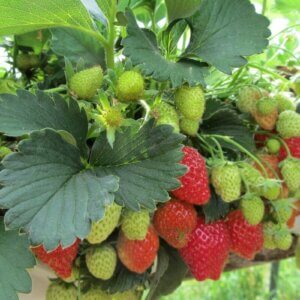In 2008, the National Agricultural Statistics Service of the USDA (USDA-NASS) conducted a first-time, in-depth survey of the US organic farming sector. A summary was published in 2010 from which it is possible to see state-by-state and crop-by-crop how many organic acres were harvested, how much they produced, and how much the crop was worth.
USDA-NASS conducts the same sort of surveys of overall US agriculture every year, so I took both data sets and put them side by side in order to compare organic with the rest of crop agriculture (not animal agriculture). I have posted that analysis as a downloadable PowerPoint slide set on SCRIBD, and I invite you to take a look at the details if you are interested. I will present a brief summary here.
Related Post: What is Organic Farming?
There are four main take-home messages from these data:
- Organic is a very small part of US agriculture
- Organic is significantly less productive on a per area basis
- Organic acreage, and to a greater extent, organic production, is skewed to the dry, Western states
- Farmers are paid higher prices for organic commodities, but when combined with lower productivity, income per acre is no always much higher and even sometimes lower
Organic: Still Tiny After All These Years
Even though I’ve been observing organic for more than 30 years, I’m always amazed at how small it is. In spite of all the hype about organic being “the fastest growing segment of the food market,” the extensive marketing, the celebrity endorsements, and the brand recognition – the amount of harvested organic cropland in 2008 represented only 0.516 percent of the total (1.6 million acres out of 309.6 million total cropland acres. See chart above). The fact that so little cropland is organic after more than 30 years of commercial and research progress suggests that organic will never be more than a niche.
For the important grain crops like wheat, soybeans, or rice, organic is well under one percent of acreage and even a smaller proportion of production. The largest of all organic crops on an area basis, Hay (402,000 acres), represents only 0.7% of the total.
There are somewhat higher percentages of organic for certain vegetable crops. About 6% of spinach production is organic and a similar proportion of squash and sweet potatoes. However, organic peppers, garlic, cantaloupes, snap beans, sweet corn and tomatoes are all less that one percent on a production basis.
In terms of fruit, apples have the highest percent organic (just under 5% in terms of production, slightly over 5% in terms of area). Most fruit crops are in the range of 1-3% organic.
Lower Productivity
To be fair, productivity was never an explicit goal of the organic philosophy or of the organic rules. Restrictions to “natural fertilizers” and to “natural pesticides” make it difficult for an organic farmer to optimize plant nutrition during periods of rapid growth and difficult to control insects, weeds and diseases. Thus, organic yields tend to fall in the 60-80% range with a few higher values and many lower values.
This may not sound like all that dramatic a difference, but for 2008, for the US to have produced the same total crop output at the organic yield levels, it would have been necessary to have harvested from an additional 132 million acres – a 43% increase. That would have represented more than the cropland equivalents of the 6 biggest farming states (IA, IL, ND, FL, KS and MN). 132 million acres is a land area the size of France or 77% of the area of Texas. Obviously, this would be impossible because there simply isn’t that much suitable land available.
Organic and Rain Don’t Mix Well
The Local Food Movement decries the degree to which fruit and vegetable production is concentrated in states like California and Washington, but this is even more true of organic cropping. The West represents 12% of all US cropland and 43% of organic. Part of this can be attributed to the lack of good fungicides for organic farming. Plant diseases usually require moisture for infection, so disease issues are less serious in the irrigated, desert West. In the Midwest, East and Southeast, there is much more rain during the growing season, and with only the old Copper-based fungicides, diseases take their toll on organic.
Apples are a good example: In Washington State, Organic apple yields are 82% of the state average. In the three biggest apple states outside of the West (NY, PA and MI), organic yields are 33%, 32% and 56% of state averages respectively. Not surprisingly, 93% of organic apple acres are in the West and 97.5% of the apple production (vs 59% and 71% for all apples). California yields are low because, with global warming, California gets more of its precipitation as spring rain rather than winter snow in the mountains. It has been causing severe disease issues for organic apple growers in the Golden State.
As another example, organic cabbage yields in California are only 59% of the state average, but in wetter GA, NY and NC, the organic yields are 23%, 6% and 14% respectively. One implication of all this is that local and organic don’t go together well for much of the US. The other implication is that the West’s significant farming problems (limited water, limited labor, urbanization) are even more exaggerated for organic moving forward.
The “Organic Premium”
Organic farmers tend to get paid more for each bushel, ton or hundredweight they produce, and of course this is passed along (usually with additional “premiums” through the chain) to the consumer. For instance, an organic potato grower in California gets paid 1.8 times as much as a conventional grower for each hundred weight of potatoes.
However; because the average organic potato yield in CA is only 56% of average, the total income per acre is exactly the same as for conventional. Whether that is more or less profitable for the grower depends on many other differences in cost structure and really isn’t addressed in this study. A California peach grower is paid 4.1 times as much per pound, but with 40% as much yield, only 1.6 times as much per acre.
An organic peanut grower in Texas was paid 1.7 times as much per pound, but with 86% average yield that means 1.45 times as much per acre income. Again, net grower economics are much more complex than this and really have to include year-to-year risk factors. The bottom line, however, is that whatever the economics, they have not been sufficient to drive very much adoption of organic in US agriculture
Conclusion
I’m glad that the USDA completed this study, and I hope they will do so periodically. The discussion of the merits or limitations of organic has long suffered from a lack of hard data. At least we now have this snapshot of 2008.
You are welcome to comment here or to contact me directly at feedback.sdsavage@gmail.com
Graphs by Steve Savage based on the USDA data
Still want to be a part of the organic niche? Check out our current selections of organic beans, rice, dairy products, and even chocolate.












































It seems everytime i turn around, something new has happened to make me feel like we are seriously loosing the battle to save our species. The bayer pesticide and now GMO alfalfa. Oh there’s so much more. Poison is always more profitable, because of yields. There is poison everywhere. Not enough to kill us, but to keep us unhealthy and consuming healthcare that we have no insurance for. But aside from that are you familiar with the Netherlands plant lab. http://www.plantlab.nl It’s fantastic but i am sure expensive. I appreciate the work you do and hope you keep it up.
Respectfully
Actually, most of the pesticides being used today on -non-Organic crops are substantially less toxic than some that are allowed on Organic – specifically copper compounds which are about the only choice an Organic grower has. Your view of pesticides is locked in the 1960s.
Steve, great article. This is really enlightening. I would never have thought that organic produce had only claimed such a small portion of the overall market. It does paint a picture of the product having a pretty steep hill to climb in order to gain any meaningful level of traction–let alone lobbying capability on the national scale.
T. Caine,
Thanks. Yes, it seems that Organic is highly unlikely to be anything but a niche. Actually it gets way more political support than is logical. One of the reasons that it seems bigger than these acreage numbers suggest is that there are lots of dry, frozen and juice concentrate ingredients being imported from places like China that are supposedly Organic. There is good reason to doubt this
When I needed to get an insurance for my farm, some one has told me about BIA, then I contacted them. They provide a insurance for my cattle farm. If You want their service please go through the link.
http://www.biainsuranceagency.com/apartment-building-questionnaire/